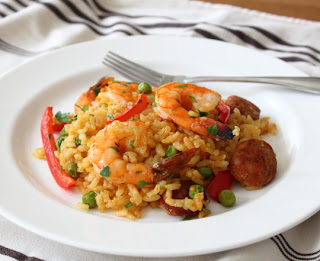When I first do a version of a classic dish like paella, I try to use a minimum of number of ingredients and steps so we focus on the technique. So, while you experienced paella makers will probably find this quite unremarkable, it really is intended for the first-timer. Real paella is not baked, but cooked on top of a fire, which results in a similarly textured rice to what you see here, except a layer caramelizes onto the bottom of the pan, and those gloriously crunchy bits are considered the best part. So, basically I’m telling you we left out the best part.
The trade-off is that this method eliminates most of the finesse and monitoring required by the traditional method. Consider this a gateway paella, and the first step to a serious, lifelong addiction. Besides the method, ideally you’ll use a wider variety of ingredients; things like clams, mussels, squid, chicken are all very commonly used, and will make your rice that much more interesting.
No matter how you cook you paella, one thing you must try to include is the saffron. Besides the short-grain rice, this is probably the most key addition. Unfortunately, the flavor and aroma are almost impossible to describe, so you really need to experience it yourself to fully understand. I’ve heard it described using things like “earthy metallic honey,” and “rusty champagne,” but these really don’t do it justice.
Anyway, if you’ve never tried to make paella before, I really hope this inspires you to give it a go. The Arborio we use here is easy to find in the big grocery stores, and as long as you stick to the liquid/rice ratio, there’s not a lot that can go wrong. And like I said in the video, stay tuned for my future attempt at a more classic version. In the meantime, I hope you give this quick and easy paella a try soon. Enjoy!
Ingredients for 4 large portions:
(best to use a 12 or 13 inch wide skillet)
For the saffron broth:
2 tsp olive oil
reserved shrimp shells from 1 pound of jumbo shrimp
1/2 to 1 tsp saffron threads, depending on how strong you want the flavor
2 1/4 cups chicken broth
*Simmer for 20 minutes, strain and reserve. Be sure to season generously with salt, or your rice will be bland.
For the paella:
1 tbsp olive oil
8 oz sliced chorizo sausage, or any smoky, spicy sausage
1/2 yellow onion, diced
2 cloves garlic, minced
1 1/3 cup Arborio rice
1/2 cup green peas
1 tsp regular or smoked paprika, optional depending on how much was in the sausage
2 cups (exactly) hot saffron broth, or just plain hot chicken broth
1 pound peeled and deveined jumbo shrimp
1 sweet red pepper, cut into thin strips
salt and cayenne to taste
garnish top with a light drizzle of extra virgin olive oil, and freshly chopped Italian parsley
lemon wedges, optional (some love lemon, I prefer without, but give it a try and see)
*Bake at 425 degrees F. for 20 minutes, then finish over med-high flame until rice is just tender. It will be firm and slightly sticky. Don’t burn it, but you can leave it on the flame a little longer to try and get the rice to caramelize and crust onto the bottom of the pan, like the classic version. Be careful.























